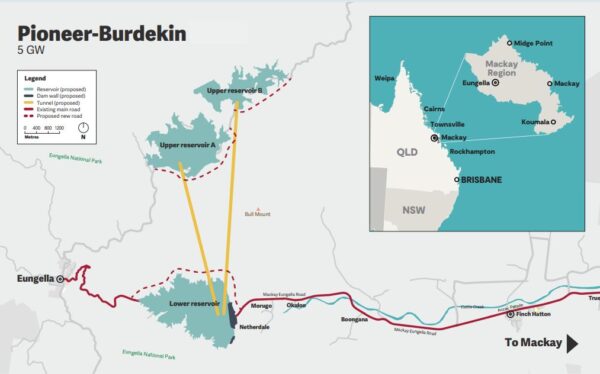The Queensland government has awarded two key contracts for what it says will be the largest pumped hydro energy project in the world, with the proposed 5 GW/120 GWh Pioneer-Burdekin pumped hydro energy storage system to form a cornerstone of the state’s energy transition.
Twin Hills Engineering and Drilling founder and owner Stephen Burt with Queensland Energy Minister Mick de Brenni.
Image: Queensland Hydro
Mackay-based business Twin Hills Engineering and Drilling and Water2Wire, a joint venture partnership between international engineering heavyweight GHD, London-headquartered civil engineers Mott MacDonald and Canadian engineering and design firm Stantec, have been awarded the first contracts for the state government’s $12 billion (USD 8.06 billion) Pioneer-Burdekin pumped hydro energy storage (PHES) project.
Planned for a site about 70 kilometres west of Mackay in the Pioneer Valley, the project is being touted as possibly the largest PHES project in the world. Proposed to be delivered in two stages by 2035, when complete the mega project is expected to be capable of providing 5 GW of generation capacity for 24 hours, equivalent to about half of the entire state’s peak usage.
Queensland Energy Minister Mick de Brenni said the project, forecast to unlock high-quality wind and solar generation sources in the nearby Central and Northern Queensland Renewable Energy Zones, will provide the long-term storage and reliability needed to power Queensland’s clean energy future.
“The project is the cornerstone of the Queensland Energy and Jobs Plan,” he said. “This mega pumped hydro project will act like a giant battery, and when connected to our Queensland SuperGrid, will underpin the reliability of our publicly owned grid by storing the energy generated by our renewable energy zones.”
With initial studies indicating there is the potential for stage one of the project to be completed by 2032, Twin Hills Engineering and Drilling has this week been awarded the geotechnical contract, which will form a key part of the exploratory stage for the project.
The six-month shallow drilling program will be used to inform project design, a fundamental part of the project’s Detailed Analytical Report. The report is due to be presented to the Queensland government in 2024.
The awarding of the geotechnical contract comes after the Water2Wire joint venture partnership was appointed to deliver the front-end engineering and design (FEED) for the Pioneer-Burdekin project.
Queensland Hydro, the new publicly owned entity established to oversee the delivery of the state government’s planned pumped hydro projects, said the Water2Wire joint venture will bring significant engineering, hydropower expertise and capability to determine the technical specifications, schedule and cost parameters for the project.
The Water2Wire team has delivered FEED design multiple projects including for Queensland Hydro’s proposed 2 GW Borumba pumped hydro project, Genex’s 250 MW Kidston PHES in north Queensland, the 1 GW Lake Onslow PHES in New Zealand, and the 3 GW Bath County PHES in the United Kingdom.
Image: Queensland Hydro
Queensland Hydro Chief Executive Officer Kieran Cusack said the appointments were an asset to the project.
“Both Twin Hills and Water2Wire had outstanding tender responses that showcased both their impressive capability and strong local links,” he said.
“With Water2Wire’s recent work on high-profile projects like Borumba and Kidston and their collective expertise in delivering pumped hydro projects around the world they will be a great asset to this project.
“We’re also delighted to be working with a local family business employing local workers.”
It is anticipate the project will support more than 3,000 jobs during construction and de Brenni said it will also offer “hundreds of supply chain opportunities.”
“It’s regions like Mackay that are at the centre of this Queensland’s renewable energy transformation – which will unleash new industrial jobs in hydrogen, renewables, manufacturing, and critical minerals,” he said.
This content is protected by copyright and may not be reused. If you want to cooperate with us and would like to reuse some of our content, please contact: editors@pv-magazine.com.
More articles from David Carroll
Please be mindful of our community standards.
Your email address will not be published.
By submitting this form you agree to pv magazine using your data for the purposes of publishing your comment.
Your personal data will only be disclosed or otherwise transmitted to third parties for the purposes of spam filtering or if this is necessary for technical maintenance of the website. Any other transfer to third parties will not take place unless this is justified on the basis of applicable data protection regulations or if pv magazine is legally obliged to do so.
You may revoke this consent at any time with effect for the future, in which case your personal data will be deleted immediately. Otherwise, your data will be deleted if pv magazine has processed your request or the purpose of data storage is fulfilled.
Further information on data privacy can be found in our Data Protection Policy.
Legal Notice Terms and Conditions Privacy Policy © pv magazine 2023
pv magazine Australia offers bi-weekly updates of the latest photovoltaics news.
We also offer comprehensive global coverage of the most important solar markets worldwide. Select one or more editions for targeted, up to date information delivered straight to your inbox.
This website uses cookies to anonymously count visitor numbers. To find out more, please see our Data Protection Policy.
The cookie settings on this website are set to “allow cookies” to give you the best browsing experience possible. If you continue to use this website without changing your cookie settings or you click “Accept” below then you are consenting to this.
Close
02 8005 6525
info@aktengineering.com.au

Recent Comments